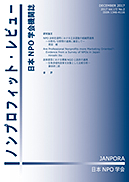Empirical studies regarding which financial information is preferred by stakeholders have been conducted in western countries. By contrast, there is no research to investigate this situation in Japan even though practical and policy discussions have occurred on expanding preferential tax treatment for contributions and the introduction of accounting standards for specified nonprofit corporations. This paper investigates a trend in which financial information is sought by donors and, using a questionnaire survey, reveals which information items donors emphasize. As a result, actually it was found statistically significant that the donors prefer to choose the financial structure that has larger program revenue even though they subjectively consider revenue from contributions to be important. On the other hand, this paper could not find statistically consistent relationships between the donors' subjective rating of importance on information items and their preference of financial structure, even though they precisely chose items such as smaller payroll costs and larger program expenses as their financial structure preferences. Although based upon a small data set, this paper reveals latent decision criteria that donors hold, which is useful in setting management policy in nonprofit organizations, and gives guidance on the disclosure of appropriate financial information.
View full abstract
